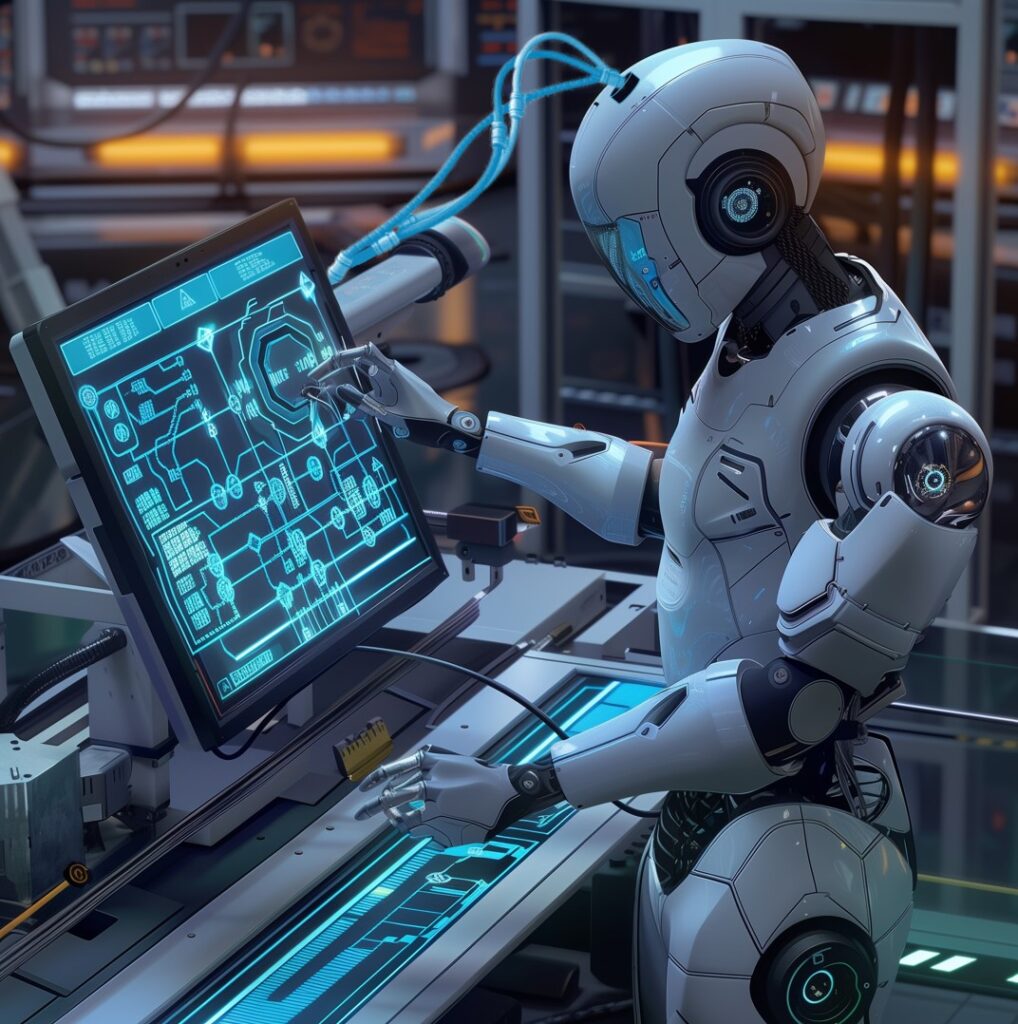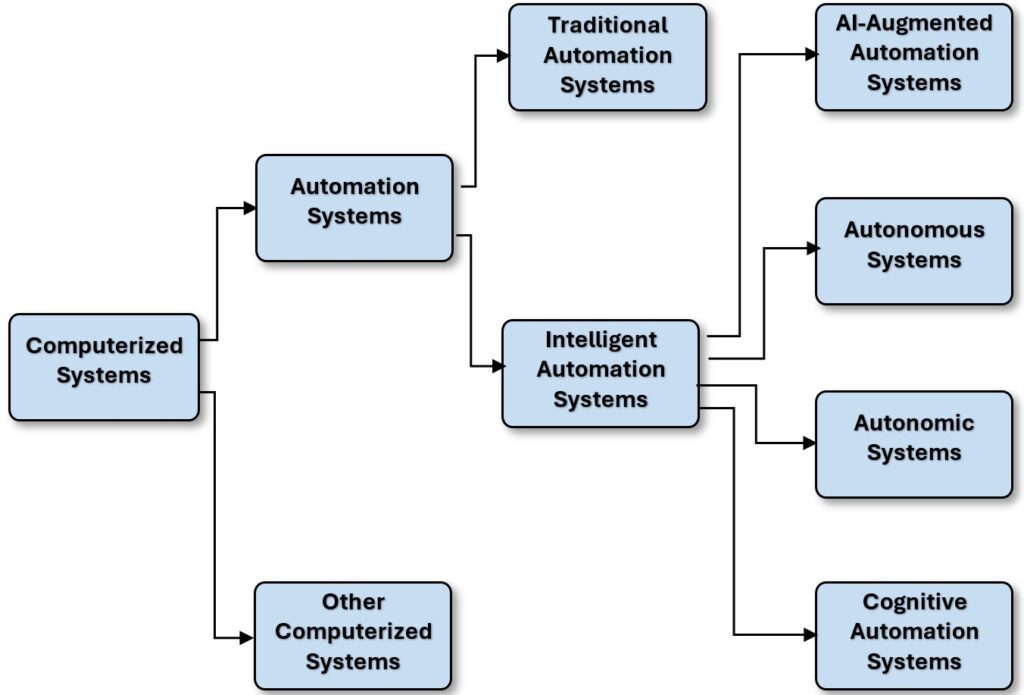
Introduction
Intelligent automation is advancing rapidly by integrating AI augmentation, autonomy, autonomic, and cognitive capabilities into automation systems. Each capability represents a different level of sophistication in how Artificial Intelligence (AI) interacts with human activity and the surrounding environment. Intelligent automation evolved from basic rule-based systems to incorporate sophisticated machine-learning algorithms. The first capability discussed in this article, AI-augmented automation, augments automation systems through a ‘partnership model’ between humans and AI, where humans and AI work together to improve the performance of automation systems. Moving beyond augmentation, autonomous capabilities allow systems to operate independently and adapt to new situations. Further advancement comes with autonomic capabilities, representing sophisticated forms of automation where systems are capable of self-management and dynamic adaptation without external intervention. Finally, cognitive automation enhances this landscape by incorporating advanced cognitive abilities into automation systems.
This article uses illustrative examples to clarify AI’s functionalities and role within each type of these capabilities, establishing a foundation for understanding them. It paves the way for further exploration of this continuously evolving landscape and its transformative impact on the future. The scope of this article covers intelligent automation systems that automate processes, decisions, tasks, and actions across various domains, such as business, IT, and industrial automation.
Basic Concepts and Definitions
Figure 1 depicts a Taxonomy of Systems that provides context for the domain of intelligent automation. It categorizes automation systems broadly as computerized systems and then narrows down to specific types of automation systems. It distinguishes between traditional and intelligent automation systems within the automation systems’ category. Then, it classifies intelligent automation systems, the focus of this article, into four categories: AI-augmented, autonomous, autonomic, and cognitive. These categories represent different levels of sophistication in how AI interacts with human activity and the surrounding environment.
It is worth noting that the boundaries between these categories can be conceptually blurry. This reflects the ongoing development of intelligent automation and the continuous advancement of these systems. For example, certain AI-augmented systems may exhibit autonomous characteristics under specific circumstances. Similarly, some autonomous systems may integrate AI functionalities that edge them towards autonomic or cognitive behaviours.
Furthermore, the practical application of these categories in real-world systems often leads to a blending of capabilities. Take self-driving cars as an example. They display autonomous features, such as independent navigation, and augmented ones, like providing driver assistance in specific scenarios. This illustrates how real-world systems can embody characteristics from various categories, further highlighting the fluidity of the boundaries in intelligent automation.
Figure 1- Taxonomy of Systems Providing Context for Intelligent Automation

Definitions of Taxonomy Nodes:
Computerized Systems: Systems that utilize computing technology to function. This extends beyond dedicated computer systems to include systems where computers play a crucial role in their functionality and operations.
Automation Systems: In the context of this article, automation systems refer to physical or software Computerized Systems that automate processes, decisions, tasks, and actions across various domains, including business, IT, and industrial automation. These systems incorporate computing technologies like hardware, software, and firmware. They may also incorporate other technologies, like sensors and actuators, which are crucial for certain automation functions.
Traditional Automation Systems: Automation Systems that do not utilize artificial intelligence. They have fixed deterministic behavior.
Intelligent Automation Systems: Automation Systems that leverage AI to automate processes, decisions, tasks, and actions.
Augmented Automation Systems: Automation Systems that leverage AI and human intelligence to automate processes, decisions, tasks, and actions. However, they often require human oversight or intervention in certain situations.
Autonomous Systems: Automation Systems that leverage AI to operate independently, and adapt to new situations. They function algorithmically without requiring human intervention.
Autonomic Systems: Automation Systems that leverage AI to operate independently. Moreover, they are self-managing, capable of analyzing their environment and optimizing their behavior to adapt to changing conditions. These systems would dynamically modify their algorithms independently, without the need for external software updates.
Cognitive Automation Systems: Automation Systems that employ AI capabilities, such as natural language processing and machine learning, to automate tasks that traditionally require human cognitive skills. These systems enable machines to perceive, learn, reason, and make decisions, mimicking human intelligence.
Other Computerized Systems: These are systems that aid human activities, excluding automation. They perform functions such as data processing and information management.
Examples of Different Categories of Automation Systems
Building on the concepts introduced in Section 2, this section leverages illustrative examples to showcase the key features of intelligent automation systems, the focus of this article. It further details specific AI techniques that could be employed within each system and explains their roles.
It should be noted that the techniques listed here are illustrative examples of potential AI techniques. The techniques chosen and how they are implemented can vary depending on the system’s design goals, data characteristics, and computational resources. Potential limitations and issues associated with these techniques should be carefully considered when selecting and implementing AI for real-world applications.
Traditional Automation Systems
Basic Supervisory Control and Data Acquisition (SCADA) system for Car Wash Tunnels: This system automates the operation of a car wash tunnel by controlling the motion of washing equipment along a track or conveyor system while vehicles remain stationary. It follows a set sequence of steps and speeds, ensuring consistent and efficient cleaning while minimizing the need for human intervention.
This system relies on pre-programmed instructions to automate repetitive predefined tasks. It does not utilize AI and has fixed deterministic behaviors.
Intelligent Automation Systems
AI-Augmented Automation System
Data Fabric Platform: This system utilizes AI and other technologies to streamline data fabric design and implementation by enabling AI-augmented data management, integration, and sharing across diverse data sources, addressing different aspects of an applications’ data needs.
The data fabric platform described in this example utilizes AI techniques to assist and augment human data management tasks. While AI can automate specific data management, integration, and sharing tasks, human intervention remains essential in several situations. This characteristic emphasizes the AI-augmentation nature of this system, where AI augments human capabilities without taking over the entire process.
Potential AI Techniques
K-Means Clustering: K-Means clustering groups similar data points, facilitating data analysis and pattern recognition.
Isolation Forest: Isolation Forest detects anomalies in data, ensuring data quality and integrity.
Random Forest: Random Forest is used for classification and regression tasks, enhancing predictive analytics within the data fabric.
Regression, Collaborative Filtering: These techniques are used for predictive modelling and recommendation systems, improving data-driven decision-making.
Graph Neural Networks (GNNs): GNNs are used for analysing and learning from graph-structured data, enhancing the understanding of complex relationships in the data.
Transformer Models (e.g., GPT or BERT): Transformer models are used for natural language processing tasks, improving the ability to understand and process textual data.
Knowledge Graphs & Active Metadata (foundation for AI-ready data management): Improve data provisioning by providing context and facilitating data discovery (Data Management Techniques).
Autonomous System
Autonomous Vehicle Cybernetic System (AVCS): This system is the intelligent core of an autonomous vehicle. It integrates software modules utilizing AI and machine learning for tasks like perception (interpreting sensor data), planning safe trajectories, and making real-time decisions. Hardware components within the AVCS, including sensors, processors, and actuators, work with the software to enable the vehicle to perceive its environment, plan its route, and execute manoeuvres for self-driving operation.
This AVCS leverages AI algorithms to process real-time sensor data (cameras, radar, LiDAR, ultrasonic sensors, GPS) for environmental perception. That enables the vehicle to independently perform the entire driving task, adapting to dynamic situations without human intervention.
Potential AI Techniques
Convolutional Neural Networks (CNNs): CNNs are used for image recognition and object detection, allowing the vehicle to perceive its surroundings.
YOLO (You Only Look Once): YOLO is a real-time object detection algorithm that helps the vehicle detect and classify objects on the road.
Simultaneous Localization and Mapping (SLAM): SLAM is used to map the environment and determine the vehicle’s location.
Model Predictive Control (MPC): MPC helps plan the vehicle’s path and control its movements.
Finite State Machines (FSMs): FSMs manage the vehicle’s behaviour based on different driving scenarios.
Kalman Filters: Kalman filters are used for sensor fusion and estimating the vehicle’s state.
Autonomic System
Distributed Routing and Obstacle Management System (DROMS) – This system operates as a decentralized autonomic system. By continuously analysing distributed environmental data (e.g., congestion, unexpected obstacles), the network of delivery robots collaboratively adapts delivery routes. This distributed decision-making optimizes efficiency and ensures uninterrupted service.
This DROMS leverages AI for self-management and real-time collaboration among delivery robots. It continuously analyses distributed environmental data and independently adapts delivery routes for each robot. DROMS showcases self-management capabilities by continuously adapting its behaviour to the environment without human intervention. However, pre-programmed algorithms likely define its core functionalities. While it can optimize routes and adapt to dynamic situations within the capabilities of these algorithms, it may need external intervention to change its core programming fundamentally.
Potential AI Techniques
YOLOv5: YOLOv5 can be used with a communication protocol that allows robots to share obstacle information, helping the system detect and avoid obstacles in real time.
Multi-Agent Deep Deterministic Policy Gradient: This technique allows the robots to learn and optimize their routing strategies through collaboration.
Soft Actor-Critic (SAC): SAC helps in optimizing the actions taken by the robots in uncertain environments.
Variational Autoencoders (VAEs): VAEs are used for anomaly detection and understanding the surrounding environment.
3.2.4 Cognitive Automation Systems
Cognitive Fraud Detection – This system employs AI to analyse patterns in financial transactions and detect fraud.
This Cognitive Fraud Detection system leverages AI algorithms to analyse large volumes of financial data. This analysis mimics the cognitive skills traditionally employed by human fraud analysts in pattern recognition and anomaly detection. By identifying suspicious transactions that might indicate fraudulent activity, the system automates tasks that previously required human expertise, improving overall efficiency and reducing the burden on fraud analysts.
Potential AI Techniques:
Deep Neural Networks (DNNs): DNNs detect complex patterns in transaction data to identify potential fraud. Combined with other techniques that offer clear explanations, this creates a more understandable cognitive fraud detection solution.
Anomaly Detection Algorithms: These algorithms identify unusual patterns in transaction data that may indicate fraudulent activity.
Natural Language Processing (NLP): NLP is used to analyse text data, such as transaction descriptions, to identify suspicious behaviour.
Clustering Algorithms: Clustering algorithms group similar transactions together to identify outliers and patterns indicative of fraud.
4. Conclusion
Intelligent automation includes various categories of systems, each with specific capabilities and sophistication levels. Augmented systems augment human activities, autonomous systems operate independently, autonomic systems manage themselves dynamically, and cognitive systems mimic human cognitive functions. The selection of the most suitable intelligent automation approach for a solution depends on several factors, such as the specific needs of the application (use cases), the maturity of the relevant technologies, and cost considerations. Understanding the distinctions and overlaps between these categories is crucial for navigating the complexities of intelligent automation. As AI advances, the lines between these categories may blur further. While predicting a single dominant intelligent automation category is difficult, the future likely holds a convergence of these categories. This convergence will likely be driven by the increasing adoption of hybrid approaches that combine functionalities from various categories to address the specific data needs of different applications.
